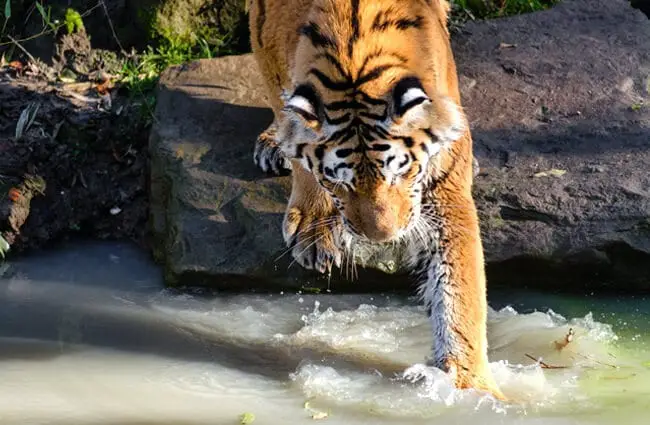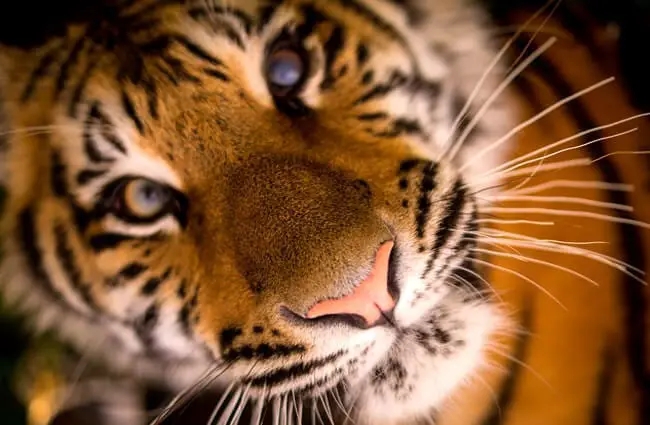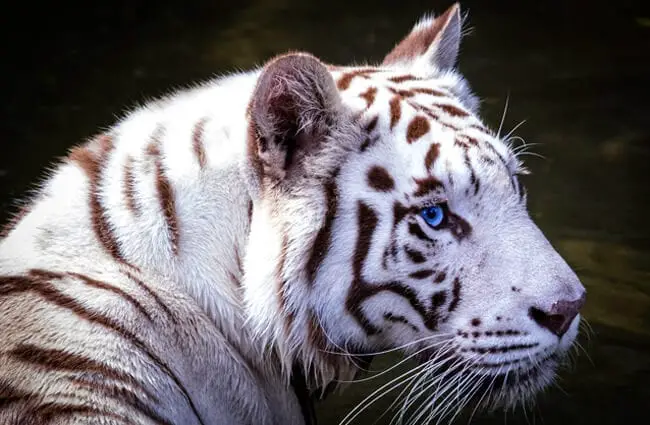Tigers are distinctive orange-and-black-striped cats that are easily recognizable and highly endangered, having been eradicated from 93% of their historic range. The nine subspecies of this animals are restricted to small pockets of Asia, and their population is estimated to be between 3,000 and 4,000 cats in the wild. Read on to learn about the tiger.
Description of the Tiger
Tigers are the largest living species of big cat. The largest subspecies are the Bengal and Siberian tigers. These cats can stand as tall as 4 ft. at the shoulder, and weigh over 800 lbs. in the wild – and even more in zoos!
They have thick fur that varies in color, but is generally a burnished orange with vertical black stripes. Their stomachs, chests, and parts of their faces are white with black stripes. The fur around the neck and chest grows thicker, but not quite as long as a lion’s mane.
Interesting Facts About the Tiger
Tigers are apex predators, and have fine-tuned anatomy and behavior for capturing large prey. From nose to their tail, these fearsome cats are perfectly adapted for hunting and survival.
- A Tiger’s Stripes – In our eyes, tiger stripes are very distinctive and bold. However, drop that pattern in a stand of tall grasses, with partial sunlight dappling through the trees and that sleek cat becomes nearly invisible. This is, of course, beneficial when stalking prey. The closer the cat can get to it’s prey before it attacks, the more likely it will catch it’s target.
- Hunting – Despite their perfect camouflage, tigers are not always successful in their hunts. Researchers estimate that only one out of every ten or twenty hunts results in a meal. This means that tigers have to choose their targets well, and hunt efficiently, if they want to survive.
- Unique Pattern – Tigers are actually the only big cats that are entirely striped. Each tiger’s stripe pattern is different from the next, and different subspecies’ stripes have different thicknesses and shapes. They even have striped skin!
- Powerful Paws – Not only are tigers’ paws equipped with long claws for grabbing prey, they are also heavily padded. This allows them to stalk through the forest almost silently. Once they find a likely target, they can leap forward twenty or thirty feet to capture their prey!
Habitat of the Tiger
The optimal habitat for tigers is located close to a water source, has lots of vegetation for cover while hunting, and plenty of prey. These are solitary hunters, so having the ability to hide in tall grasses and bushes while stalking prey is of the utmost importance.
They also prefer living in habitats with suitable den locations, such as caves, hollow trees, or very dense bushes. Different subspecies can be found in a number of forest types, including evergreen, swamp, mangrove, deciduous, thorn, and taiga. They will also occasionally inhabit rocky mountain habitats, as well as savannas and grasslands.
Distribution of the Tiger
Sadly, tigers have lost 93% of their former range in Asia. They can no longer be found in western or central Asia, Bali, Java, and around the Caspian Sea. Nowadays, small pockets of tigers can be found in India, Russia, Bangladesh, North Korea, Bhutan, Indonesia, Nepal, Malaysia, Myanmar, China, Vietnam, Cambodia, Laos, and Sumatra.
The tiger populations in these areas are highly fragmented. This means that the tigers are separated by large expanses of land, and cannot breed with one another.
Diet of the Tiger
Tigers prefer medium and large prey items, especially ungulates, or hoofed mammals. They normally hunt animals that are 200 lbs. or more. Some of their favorite prey species include deer, buffalo, chital, nilgai, swamp deer, Indian bison, wapiti, tapir, orangutan, monkeys, camels, fish and wild boar. They will also sometimes hunt other predators like dogs, crocodiles, leopards, and sloth bears.
Tigers hunt using ambush, and will quietly stalk their prey to get close enough to capture it. Successful hunting requires skill and precision. Sometimes when tigers become injured or too old to hunt, they will resort to hunting humans. This can cause extreme conflict between native people and tigers.
Tiger and Human Interaction
Man-eating tigers are relatively rare, but still a problem in Asia. This can cause native people to become fearful and resent tigers, compounding conservation struggles. Humans have been consistently decimating tiger populations for years. Tigers are considered a top game species in Asia, and were hunted for sport as well as their fur.
Other hunting came as a result of retaliation to attacks, and to supply traditional Chinese medicine. This trade is fueled by the false belief that tiger parts have use as painkillers and aphrodisiacs. The black market trade of tiger parts and furs, fuels poaching to this day.
Domestication
Tigers have not been domesticated in any way.
Does the Tiger Make a Good Pet
The tiger does not make a good pet. They are the largest cat species, and extremely powerful. These cats have been known to kill humans, and should not be owned as pets.
Tiger Care
In zoos, tigers must be provided with lots of enclosure space to exercise and interact. They are provided with a water feature as well, because tigers enjoy swimming. To keep the tigers stimulated, they are provided with environmental enrichment in the form of large toy balls, floats, branches and logs, ice blocks, puzzle toys, and more.
To better care for tigers, they are trained using positive reinforcement to participate in their own healthcare. This keeps zookeepers from having to tranquilize the tiger for checkups and some medical procedures. Tigers can be trained to stand on scales for weighing, allow their blood to be drawn, open their mouths so their teeth can be assessed, and more!
Behavior of the Tiger
Adult tigers are solitary creatures, and rarely interact with other tigers. They maintain territories, but will travel outside of these territories regularly. The territories of females will commonly overlap with males, but the territories of two males will not.
Tigers swim frequently, and will bathe in ponds, lakes, rivers, or streams. They also use water sources as an escape from the heat, and thoroughly enjoy swimming. Female cubs will establish territory close to their mothers, and slowly disperse over time. Males have territories much larger than females, and will check these territories to determine if any females are receptive to mating.
Reproduction of the Tiger
After a gestation period of 93 – 112 days, the female tiger will give birth to a litter of cubs. After 5 – 6 months the cubs are weaned off of their mother’s milk, and she will teach them how to hunt. By the time they are 11 months old, the cubs will be capable of hunting on their own. At 18 months they become fully independent, but will remain with their mother for 2 years or more.
Beliefs, Superstitions, and Phobias About the Tiger
Tigers are found quite frequently in Asian culture and mythology. They are one of the twelve creatures in the Chinese Zodiac, and are featured in a number of tales and folklore. In Buddhism, tigers are a symbol of anger, and are considered one of the Three Senseless Creatures.
The Tungusic people treat the tiger as a deity, and the Manchu people consider the tiger to be “Hu Lin,” or “the king.” It is no wonder that tigers are so prevalent in so many cultures, considering how powerful and awe-inspiring they are.













![Red Angus Closeup of a beautiful Red Angus cowPhoto by: U.S. Department of Agriculture [pubic domain]https://creativecommons.org/licenses/by/2.0/](https://animals.net/wp-content/uploads/2020/03/Red-Angus-4-238x178.jpg)












![Red Angus Closeup of a beautiful Red Angus cowPhoto by: U.S. Department of Agriculture [pubic domain]https://creativecommons.org/licenses/by/2.0/](https://animals.net/wp-content/uploads/2020/03/Red-Angus-4-100x75.jpg)

